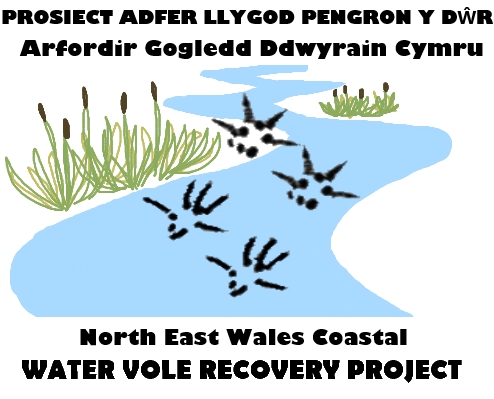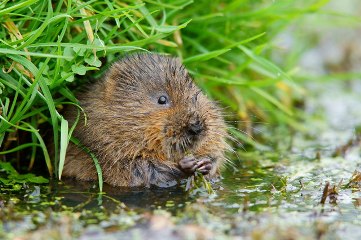Biodiversity
Latest News
A Starring Role for Nantclwyd’s Lesser Horseshoe Bats
22.05.2015
Living Landscape Brought Back to Life
05.12.2014
Facebook Page
Water vole
North East Wales Coastal Water Vole Recovery Project
The water vole is the largest of the British voles and is often mistaken for a brown rat. Confusingly their other name is the water rat (just like ‘Ratty’ the water vole from Wind in the Willows). They can be distinguished from brown rats by their furry tails, smaller, round ears and a flatter face.

They like to eat water side vegetation such as grasses, sedges and rushes, but can feed on other plants and insects, having to eat up to 80% of their bodyweight in food every day. They have between two and five litters a year, producing five to eight young every time, but infant mortality is high and few of them live longer than three years.
Water voles live near the water and prefer waterways with a slow flow and steep banks within which they can excavate their burrows. There are usually multiple entrances into a water vole burrow; some entrances will be under the water, others near the water’s edge and others higher up on the bank. This multi-entrance burrow system allows the vole to quickly escape from potential predators and entrances higher up on the bank function as refuges during times of water level fluctuations.

History
Formerly widespread across the waterways of the UK, the water vole is known as Britain’s fastest declining mammal. In the past decade the numbers of water vole have declined an estimated 90%.
The main reasons for the decline of water voles are the reduction in suitable habitat and predation by American mink.
Project
As part of the North East Wales Coastal Water Vole Recovery Project we are asking for the public to join in the ‘vole hunt’ by reporting any sightings they have of water voles in the North East Wales area.
We have a basic understanding of water vole distribution in our project area but we have lots of gaps and many of the sightings are very old. At the moment people might be spotting water voles when they go on walks or are lucky enough to see them at a local pond or ditch, but they are keeping the information to themselves and we would like them to share it with us so that we can target conservation efforts more effectively.
To report your water vole sighting please visit www.cofnod.org.uk and click on the ‘Record a Water Vole’ icon.
To keep up to date with the projects progress why not follow us on facebook!



